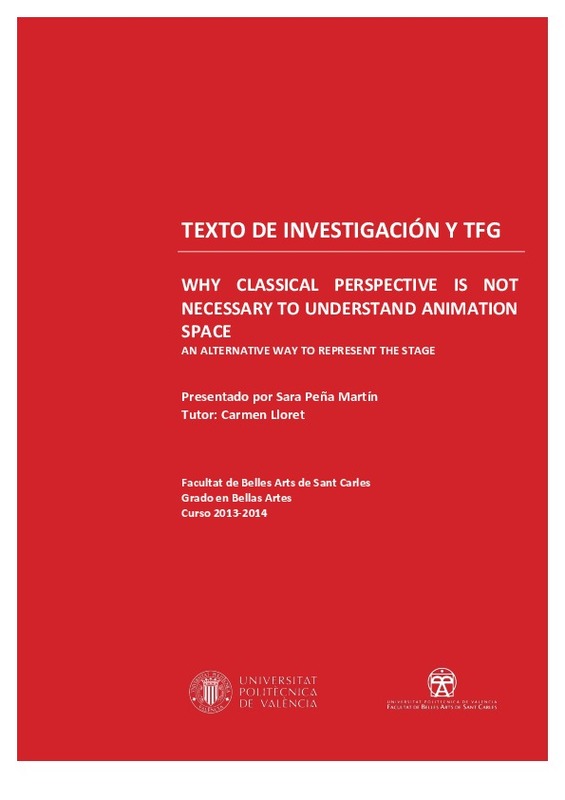JavaScript is disabled for your browser. Some features of this site may not work without it.
Buscar en RiuNet
Listar
Mi cuenta
Estadísticas
Ayuda RiuNet
Admin. UPV
Why classical perspective is not necessary to understand animation space. An alternative way to represent the stage
Mostrar el registro sencillo del ítem
Ficheros en el ítem
| dc.contributor.advisor | Lloret Ferrándiz, M. Carmen
|
es_ES |
| dc.contributor.author | Peña Martín, Sara
|
es_ES |
| dc.date.accessioned | 2015-05-21T09:25:13Z | |
| dc.date.available | 2015-05-21T09:25:13Z | |
| dc.date.created | 2014-09 | |
| dc.date.issued | 2015-05-21 | |
| dc.identifier.uri | http://hdl.handle.net/10251/50614 | |
| dc.description.abstract | Nowadays, in the Western culture, it seems that “Perspective” is the only globally accepted way of understanding the graphic representation of objects in space. However, before this modern concept was understood as the main one to represent objects in depth, in other historical periods and distant cultures they had chosen completely different ways of representing space. This is a researching dissertation that is understood as a theoretical work related to the animation short film We are Glad, the personal final degree project of the author. In it, the alternative ways of representing space that differ from the Renaissance perspective has been analysed, and how they have influenced in the late animation world. When we talk about alternative ways of representing space, we are referring to systems like the one that took place during the High Middle Ages, or in distant cultures such as Africa or Oceania, in which object ‘s size and distribution in images don’t follow the same rules that we would do nowadays. In order to enclose our research field, the main examples that will be analysed are two that, in some way, share some aspects in common with We are Glad: The High Middle Ages art and its relationship with the American fifties cartoons. Thus, all the important aspects of these examples will be exposed and analysed in order to argument the main thesis of the dissertation: why traditional perspective is not necessary to understand space in animation. | es_ES |
| dc.description.abstract | En la sociedad occidental actual, parece existir una concepción globalmente aceptada de la representación gráfica en perspectiva del espacio. Sin embargo, antes de que este renacentista concepto de representar los objetos en profundidad se impusiese como sistema mayoritario, han existido otras épocas y otros lugares en las que el espacio se ha representado de una forma completamente diferente. Este texto de investigación se plantea como un trabajo teórico relacionado con el cortometraje de animación We are Glad, proyecto personal de final de grado de la alumna. En él, se ha pretendido realizar un análisis de los sistemas de representación del espacio alternativos a la visión occidental moderna de la perspectiva, y cómo estas alternativas han resultado una evidente influencia posteriormente en el mundo de la animación. Por sistemas alternativos de representación entendemos el que se daba en la Alta Edad Media, o en culturas como la africana o la oceánica, en las cuales el tamaño de los objetos y la disposición de los mismos en la imagen dependían de factores muy diferentes a los que hoy en día seguiríamos. Para acotar el campo de investigación, los principales ejemplos que se explorarán en este ensayo serán dos periodos de la historia que comparten aspectos en común con el proyecto personal de la alumna: El arte medieval de la Alta Edad Media y su relación con la animación americana de los años 50. Así, a lo largo del texto se irán exponiendo y analizando todos los aspectos de estos dos ejemplos que sirven para argumentar y demostrar la tesis expuesta en el título del texto: que la perspectiva no es necesaria para entender el espacio en la animación. | es_ES |
| dc.format.extent | 35 | es_ES |
| dc.language | Inglés | es_ES |
| dc.publisher | Universitat Politècnica de València | es_ES |
| dc.rights | Reconocimiento - No comercial - Sin obra derivada (by-nc-nd) | es_ES |
| dc.subject | Animación americana | es_ES |
| dc.subject | Cortometraje | es_ES |
| dc.subject | Cartoon | es_ES |
| dc.subject | Pintura medieval | es_ES |
| dc.subject.classification | DIBUJO | es_ES |
| dc.subject.other | Grado en Bellas Artes-Grau en Belles Arts | es_ES |
| dc.title | Why classical perspective is not necessary to understand animation space. An alternative way to represent the stage | es_ES |
| dc.type | Proyecto/Trabajo fin de carrera/grado | es_ES |
| dc.rights.accessRights | Abierto | es_ES |
| dc.contributor.affiliation | Universitat Politècnica de València. Departamento de Dibujo - Departament de Dibuix | es_ES |
| dc.contributor.affiliation | Universitat Politècnica de València. Facultad de Bellas Artes - Facultat de Belles Arts | es_ES |
| dc.description.bibliographicCitation | Peña Martín, S. (2014). Why classical perspective is not necessary to understand animation space. An alternative way to represent the stage. http://hdl.handle.net/10251/50614. | es_ES |
| dc.description.accrualMethod | Archivo delegado | es_ES |
Este ítem aparece en la(s) siguiente(s) colección(ones)
-
BBAA - Trabajos académicos [4557]
Facultad de Bellas Artes





![[File]](/themes/UPV/images/mime.png)

